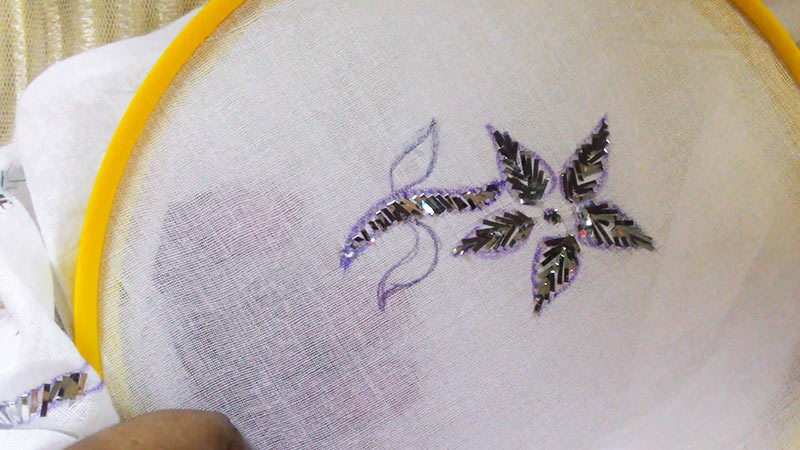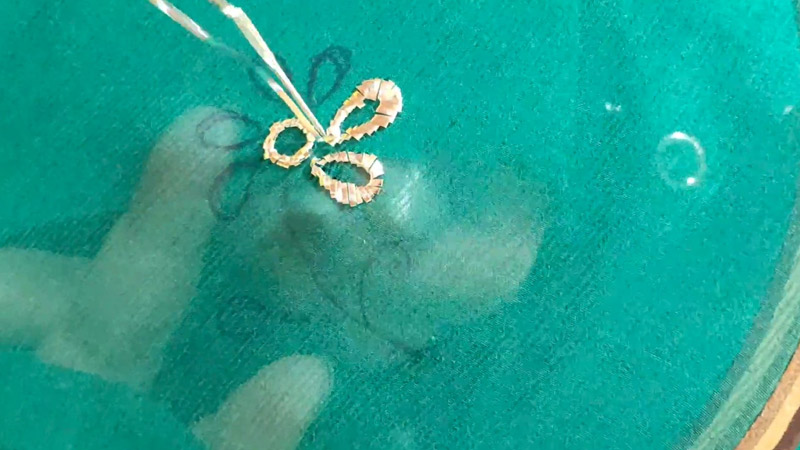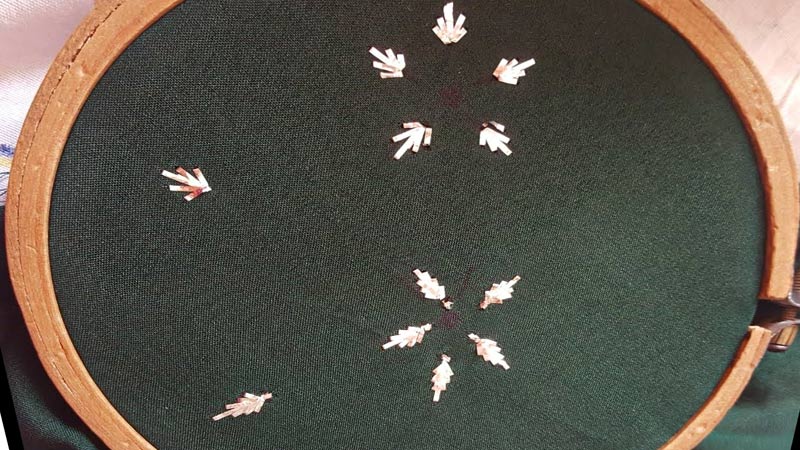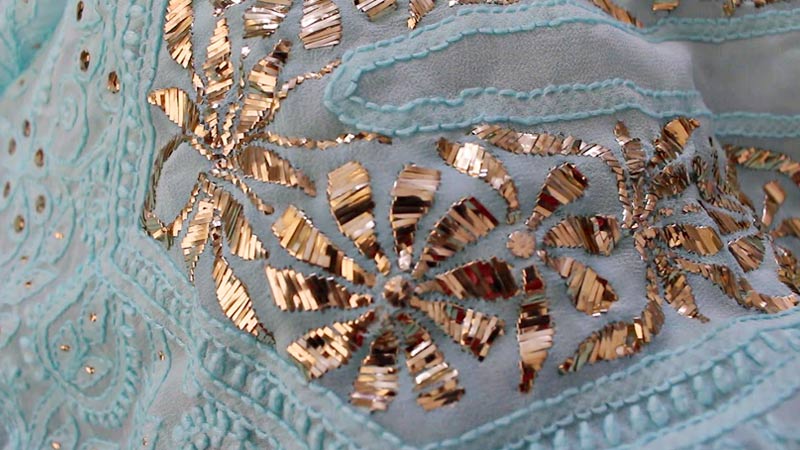Kamdani embroidery, a sublime form of craftsmanship, traces its roots to the rich tapestry of South Asian textile traditions.
Embedded with history and cultural significance, Kamdani embroidery showcases an intricate dance of skilled hands weaving magic onto fabric.
Originating from the Indian subcontinent, this art form has transcended time, adorning fabrics with its timeless elegance.
Derived from the Persian word “Kam” (meaning work) and “Dani” (meaning needle), Kamdani involves meticulous hand-stitching using fine metallic threads, sequins, and beads.
The resulting patterns shimmer with a celestial glow, creating garments that are not merely attire but tangible stories of heritage.
As we delve into the essence of Kamdani embroidery, we unravel everything you need to know about what is Kamdani embroidery.
We’ll discover all the related threads that connect craftsmanship, culture, and creativity, revealing a timeless artistry that continues to captivate hearts across borders.

What Is Kamdani Embroidery? Understanding the Origin of Kamdani Work
Kamdani embroidery, a jewel in the crown of South Asian textile heritage, is an intricate and timeless art form that has captivated hearts for centuries.
Originating from the Indian subcontinent, the term “Kamdani” finds its roots in the Persian language, where “Kam” translates to work and “Dani” to needle. It’s also known as ‘Kamdaani‘ or ‘Kaam Dani‘.
This exquisite form of embroidery involves a meticulous hand-stitching process using fine metallic threads, sequins, and beads, resulting in garments that radiate a celestial glow.
Historical Tapestry: Roots and Evolution
To comprehend the essence of Kamdani embroidery, one must delve into its historical tapestry. With roots dating back to ancient times, this art form has evolved through the dynasties and diverse cultures that have graced the Indian subcontinent.
Initially known for adorning royal garments, Kamdani has seamlessly woven itself into the fabric of various traditions.
Materials and Techniques: The Symphony of Threads

Central to Kamdani embroidery is the skillful use of materials and techniques that transform ordinary fabric into a canvas of opulence.
Artisans employ a specialized needle, known as a kam or hook needle, to meticulously create intricate patterns on the fabric.
The metallic threads, often gold or silver in color, bring a regal touch, enhancing the overall allure of the Kamdani dresses.
Sequins and beads, meticulously stitched into the fabric, add a dimensional quality and a luminous sheen, creating a visual feast for the eyes.
Cultural Significance: Beyond Ornamentation
Beyond its visual appeal, Kamdani embroidery carries profound cultural significance. It serves as a symbolic language, weaving tradition, spirituality, and identity narratives.
Often employed in bridal wear and ceremonial attire, Kamdani becomes a custodian of familial and communal heritage.
The careful selection of motifs, influenced by regional aesthetics, folklore, and symbolism, reflects the diverse cultural mosaic of the subcontinent.
Regional Variances: A Kaleidoscope of Styles

Kamdani embroidery is not a monolithic art form but a kaleidoscope of regional styles, each unique. In Lucknow, the heartland of Kamdani craftsmanship, the art form flourished under the patronage of the Mughal emperors.
Lucknawi Kamdani is characterized by its delicate floral motifs and intricate geometric patterns. Meanwhile, Kashmiri Kamdani, influenced by the valley’s breathtaking landscape, often features intricate paisley patterns and nature-inspired designs.
The Artisan’s Hand: Craftsmanship in Focus
The artisan’s skill is at the core of Kamdani embroidery, passed down through generations. Each piece is a labor of love, demanding unwavering patience and precision.
The handcrafted nature of Kamdani distinguishes it from mass-produced alternatives, highlighting the artistry and dedication woven into every stitch.
The intimate connection between artisan and creation adds an intangible quality, turning each piece into a unique masterpiece.
Evolution in Modern Times: Adapting to Change

While Kamdani embroidery proudly preserves its historical roots, it is not immune to the winds of change. Kamdani fabric has seamlessly adapted to new styles and tastes in contemporary fashion landscapes, transcending its traditional confines.
Designers worldwide have embraced its timeless appeal, incorporating Kamdani elements into diverse fashion genres, from bridal couture to contemporary streetwear.
Challenges and Preservation Efforts: Nurturing Tradition
Despite its enduring allure, Kamdani embroidery faces challenges in the modern era. Economic factors, changing consumer preferences, and the rise of machine-made alternatives threaten this artisanal craft’s survival.
Organizations and artisans alike recognize the need for proactive measures to ensure the preservation and sustainability of Kamdani embroidery.
Initiatives aimed at skill development, market access, and cultural appreciation play a vital role in nurturing this delicate art form.
Global Appreciation: Beyond Borders
Kamdani embroidery has transcended geographical boundaries, finding admirers worldwide who appreciate its artistry.
The global fashion stage recognizes the uniqueness and timelessness of Kamdani, making it a sought-after embellishment in international design circles.
This cross-cultural appreciation brings economic opportunities for artisans and fosters a broader understanding of the cultural richness encapsulated in each embroidered piece.
What Are the Uses and Benefits of Kamdani Embroidery?
Now that you know what is Kamdani work, let’s explore its uses. From cultural expression to contemporary fashion, Kamdani seamlessly weaves its magic, leaving an indelible mark on diverse aspects of life.
Bridal Couture: A Touch of Opulence

Kamdani embroidery has earned its place as a quintessential element in bridal couture. The opulent metallic threads, sequins, and beads transform bridal ensembles into regal masterpieces.
Bridal attire embellished with Kamdani embroidery not only exudes elegance but also carries emotional weight, symbolizing the sanctity of the union and the continuation of familial traditions.
Ceremonial Attire: Elevating Celebrations
Beyond weddings, Kamdani embroidery graces various ceremonial attires, enhancing the grandeur of festive occasions.
Whether it’s religious ceremonies, cultural celebrations, or significant milestones, garments adorned with Kamdani become a visual spectacle, adding a touch of sophistication and cultural richness to the festivities.
Home Décor: A Touch of Luxury
Kamdani embroidery extends its influence beyond personal attire, finding a place in home décor. From luxurious bedspreads to exquisite pillow covers and wall hangings, the artistry of Kamdani elevates living spaces.
The intricate designs and shimmering threads bring a touch of luxury to the interiors, creating an ambiance of refined elegance.
Fashion Fusion: Contemporary Adaptations
In the world of fashion, Kamdani embroidery has transcended traditional boundaries, seamlessly blending with contemporary styles. Designers globally have embraced its timeless appeal, incorporating Kamdani elements into diverse fashion genres.
From modern silhouettes to fusion wear, Kamdani adds a touch of tradition to avant-garde designs, creating a harmonious fusion of the old and the new.
Global Recognition: A Cross-Cultural Appeal
The appreciation for Kamdani embroidery extends far beyond its cultural origins. Designers and enthusiasts recognize its uniqueness and craftsmanship in the global fashion landscape.
Kamdani has become a sought-after embellishment in international design circles, fostering cross-cultural appreciation and creating economic opportunities for artisans on a global scale.
Handcrafted Luxury: Uniqueness in Every Stitch
The labor-intensive nature of Kamdani embroidery contributes to its allure. Skilled artisans meticulously handcrafted each piece, ensuring that no two creations are identical.
This uniqueness sets Kamdani apart from mass-produced alternatives, adding a layer of exclusivity and individuality to the garments and accessories adorned with this intricate embroidery.
Economic Empowerment: Sustaining Artisan Livelihoods
Kamdani embroidery plays a crucial role in sustaining artisan livelihoods. As a labor-intensive craft, it provides employment opportunities for skilled artisans, often in regions where traditional craftsmanship is vital to the local economy.
Supporting Kamdani helps preserve an art form and the livelihoods of those who dedicate their skills to its continuation.
Sustainable Fashion: A Counter to Mass Production
In an era dominated by fast fashion and mass production, Kamdani embroidery stands as a beacon of sustainable fashion.
The emphasis on handcrafted techniques and using traditional materials contribute to a more sustainable approach to fashion.
Choosing Kamdani promotes ethical practices and encourages a shift towards mindful consumption.
Emotional Connection: Beyond Aesthetics
Lastly, the benefits of Kamdani embroidery extend beyond the aesthetic realm. Wearing or owning a piece adorned with Kamdani creates a unique emotional connection.
It carries stories of craftsmanship, cultural heritage, and the dedication of artisans, fostering a deeper appreciation for the art form and its significance in the broader context of personal and cultural identity.
FAQs
What is Kamdani embroidery, and what sets it apart from other embroidery techniques?
Kamdani embroidery is a traditional South Asian craft known for its intricate hand-stitching using fine metallic threads, sequins, and beads.
What distinguishes Kamdani is its meticulous artistry, often involving regal gold or silver threads, and its unique ability to blend historical elegance with contemporary fashion, setting it apart from other embroidery techniques.
How is Kamdani embroidery done, and what materials are typically used in the process?
Kamdani embroidery involves a skilled hand-stitching process using a specialized needle called a kam or hook needle. Artisans meticulously sew intricate patterns on fabric, incorporating fine metallic threads, sequins, and beads.
What are the cultural significance and traditional uses of Kamdani embroidery?
Kamdani embroidery holds profound cultural significance, often adorning bridal wear, ceremonial attire, and traditional garments. It becomes a symbolic language, expressing cultural heritage, regional aesthetics, and stories of identity.
How has Kamdani embroidery evolved in contemporary times, and how is it adapted to modern fashion?
In contemporary fashion landscapes, Kamdani embroidery has evolved beyond its traditional confines. Designers worldwide have embraced its timeless appeal, incorporating Kamdani elements into diverse fashion genres.
Is Kamdani embroidery sustainable, and how does it contribute to artisan livelihoods?
Kamdani embroidery aligns with sustainable fashion principles due to its emphasis on handcrafted techniques and the use of traditional materials. The craft contributes significantly to sustaining artisan livelihoods, providing employment opportunities for skilled craftspeople.
Conclusion
Kamdani embroidery is a testament to the enduring legacy of artisanal craftsmanship, weaving a narrative that transcends geographical boundaries.
Its intricate patterns and celestial shimmer not only adorn fabrics but also symbolize a cultural continuum, echoing the tales of generations past.
As we contemplate the stitches that bind tradition with contemporary allure, Kamdani bridges heritage and modernity.
In a world where the pace of change is relentless, this age-old art form reminds us of the beauty of meticulous, handcrafted endeavors.
Kamdani embroidery’s ability to evolve while preserving its cultural essence ensures its place as a timeless treasure.
It is not just an embellishment on fabric; it is a living canvas that narrates stories of skill, tradition, and the exquisite beauty that emerges when the past and present interlace in the delicate dance of a needle and thread.
Leave a Reply